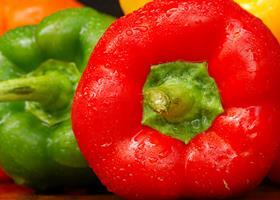
Although the recently averted strike in key Spanish producing region Almería has relieved short-term pressures ahead of Easter, the salads sector still faces challenges at the transition to Dutch supply.
The fact that Europe effectively had no winter has been causing headaches for months with Spanish salad crops, and in particular Iceberg, failing to develop fully. The effect is that high prices typically prompted by supply crossover and high demand in the run up to Easter could last for around six weeks from now until April.
Senior buyer at foodservice firm Reynolds, Matt Jones, explains: “At the moment Dutch produce isn’t higher than normal, but what will happen is the longevity will cause some problems – after Spain finishes, Dutch supply will have nothing to compete with so they will hold those prices.”
Jones says he expects the Dutch crop to be down slightly in certain categories, including green peppers. “Red, orange and yellow pepper acreage has risen, which has been designed to stabilise prices,” he says. “Loose tomato acreage is down, vine and beef are down. Cucumbers are slightly down.”
Robert Voskamp, managing director of Vitaal Europe, says the biggest talking points in Dutch salads at the moment are the early-ending season from Spain, and an early Easter. “There may be a gap in the market, mainly for capsicums and tomatoes, but we aren’t envisaging any real problems.
“The Dutch season won’t fully start for another three weeks or so, so there could potentially be a gap in the market especially leading up to Easter. Growing conditions are looking good, we had a reasonably good winter with some sunlight.”
Smaller size tomatoes and peppers are another area that could face some shortages during this Dutch season, according to managing director of salad supplier Quality Produce International (QPI), Marcel Paul. He says: “On peppers I’m not anticipating a big shortage overall, just in small sizes. Varieties are all bigger and bigger to give growers higher yields. This means until summer we will have a shortage in smaller peppers, which are needed for prepacking.”
Paul says there have been some issues with smaller vine tomato varieties, and medium vines are expected to be limited, but there will be plenty of cocktail. Volume on cucumbers in the main UK retail size of 350g to 400g is low, while aubergine volumes are normal, he adds.
“Expectations prior to season were high on price, but all will depend on alternative supply from within Europe,” he says, adding that exchange rates and a potential repeat of the Calais disruption this summer could also affect the season.
Looking further ahead, Jones believes the Netherlands could soon face increased competition from Belgium, which he says is catching up in terms of innovation in growing and product ranges.
“New countries are coming through into salad supply, such as Belgium, which is catching up with growing and NPD due to increased investment back into companies. The Belgians are slightly behind in how to market their products, they need to become as commercially astute as the Dutch, but it’s only a matter of time.”
Meanwhile development in Dutch salads is coming from sizing within existing categories, rather than pure NPD, Jones believes. “They are looking at specs more than anything else,” he says.
“Looking at what trends there are in salads more widely, there is still lots of interest in anything with antioxidants, or anything ‘super’, such as a baby kale leaf.”



